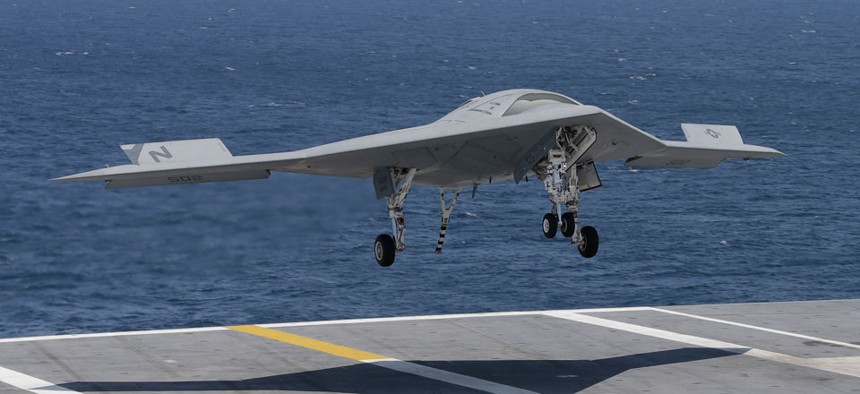
An X-47B landing on the deck of the USS George H.W. Bush Steve Helber/AP
The Next QDR Is the Last Chance for Sanity
The independent review panel could be a real opportunity for change.
The next nine months will be the most important period for United States defense strategy since the end of the Cold War. The highly anticiapted Quadrennial Defense Review and, perhaps more importantly, the congressionally mandated National Defense Panel that is tasked to assess the QDR, offer the last chance to truly reshape the U.S. military for the future. If hard choices are not made between now and the QDR’s release in February 2014, it will become exponentially more difficult to prevent an erosion of American military power.
The stakes are therefore very high for the Pentagon’s next QDR. But having toiled through the last QDR process, it is hard for me to see how the massive bureaucracy will be able to enact the sweeping changes that are required in order for the U.S. to truly sustain its military advantages into the future.
A confluence of factors make this period particularly important. The longest ground war in American history is ending, defense budgets are declining sharply, and internationalists on both sides of the aisle are being pressured by those who believe, not unreasonably, that the U.S. ought to be less involved overseas militarily. These powerful domestic trends are joined by other influential forces: a rising and more assertive China investing heavily in its military; unrest throughout the Arab world; a North American energy boom that will radically reshape global energy flows; and the rapid shift toward a warfighting regime dominated by unmanned and autonomous robotic systems.
Given this level of change, one might expect that Congress and the executive branch would be devoting significant time and effort to prepare for major changes in the size and shape of America’s military. One might think there is a cohesive effort underway to set out a clear path to maintain U.S. technological advantages in the face of real competition by China and others. But it’s not happening.
Instead, we have the Pentagon struggling to deal with the madness that is sequestration. The months-long Strategic Choices and Management Review is not expected to result in any decisions of consequence. Despite a strong bipartisan consensus that another round of base closures, rightsizing DOD’s civilian workforce, and reforming military compensation are fundamental in order to resource a strong future-oriented military, there are no voices in Congress or the Pentagon that are loudly making the case for change.
There are many reasons for DOD’s inability to make hard choices, but a particularly pernicious one is the difficulty in suppressing the ravenous appetite for capacity today. Combatant Commands -- which oversee U.S. military operations across entire regions of the globe, like the Pacific, Africa, or Central Asia -- consistently demand more forces, more presence, and more money to address today’s perceived threats. The military services use this demand signal to resist cuts to force structure and end-strength. But during a drawdown, the demand for today’s capacity comes at the expense of investment for tomorrow’s capability. This has real consequences.
Just last week the Navy made history by landing an experimental unmanned plane on the deck of an aircraft carrier. The ability to operate long-range unmanned surveillance and strike systems from carriers would revolutionize naval aviation, enhance the survivability of aircraft carriers, and lock in America’s technological advantage over emerging rivals. One would think the Navy would jump at the chance to use these prototypes for continued testing and experimentation until they literally fell out of the sky. Instead, the Navy intends to quickly scrap these revolutionary planes and put them in a museum. A follow-on program will focus on a developing a Predator-like capability more suited to counterterrorism missions than real power projection into contested areas. If that’s not defense malpractice it’s hard to see what is.
There are any number of other examples that call into question the ability of DOD to aggressively look inward to make the hard choices and take on the sacred cows. It’s not that senior policymakers at the Pentagon don’t want or intend to make big decisions, but history suggests they’ll have trouble. They could use some help.
Enter the congressionally appointed National Defense Panel, charged with providing an outside assessment of the QDR. The panel, co-chaired by former Defense Secretary William Perry and former U.S. Central Command chief General John Abizaid, is tasked with not only reviewing the final product, but offering assessments along the way. Staffed and resourced appropriately, the panel stands a decent chance of having a major influence—acting as the Simpson-Bowles Commission for DOD, speaking hard truths to both Congress and the Pentagon, and providing useful top cover for leaders to make tough decisions.
Many defense analysts and reporters dismiss QDRs as irrelevant exercises that rarely prove decisive in changing the course of U.S. defense strategy. They are partially correct -- no defense review is automatically influential. But if the right factors come into alignment at the right time, change can happen. With wars ending, budgets declining, technology proliferating, and other powers rising, a real window of opportunity to reshape U.S. defense strategy has opened for the first time since the end of the Cold War. It will close within a year. Time to get moving.
NEXT STORY: Building a Better Soldier-Diplomat
